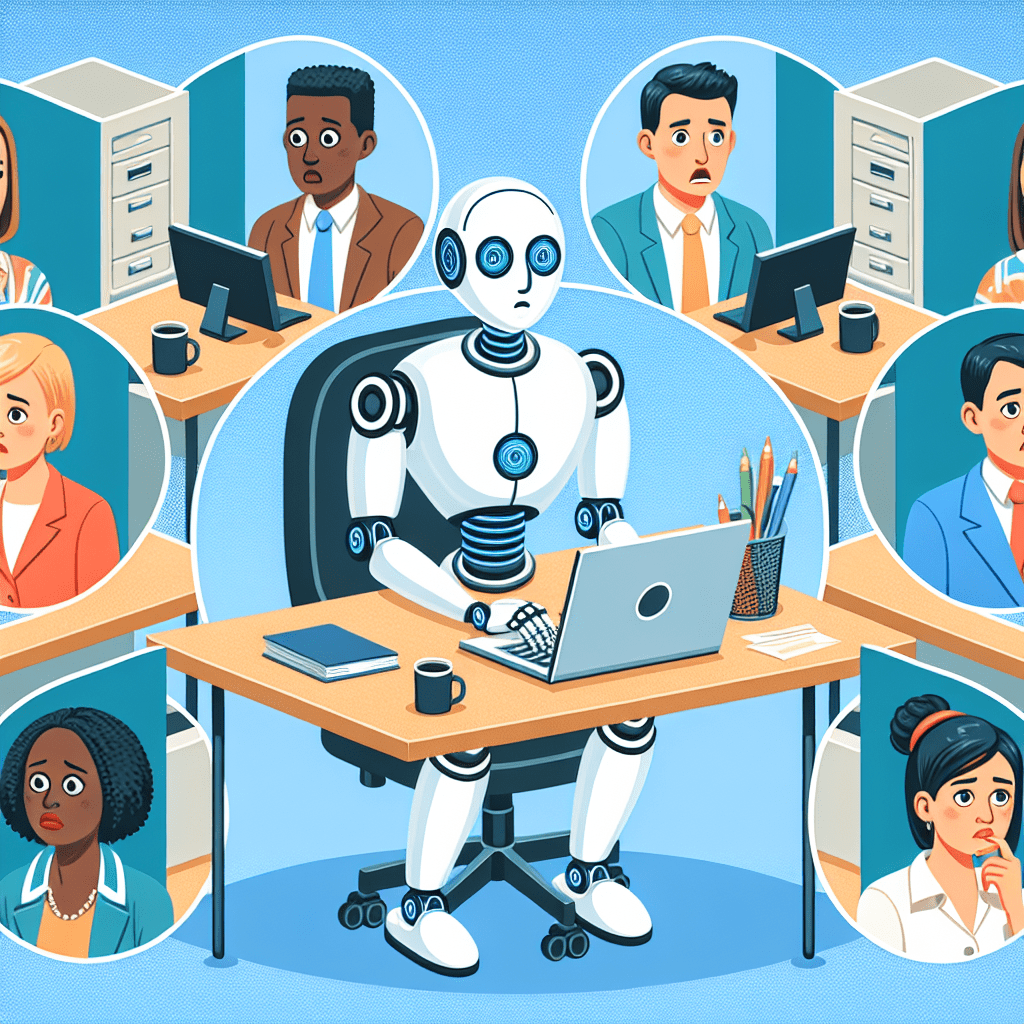
Blogpost / AI Job Displacement and What Can Go Wrong – An opinion piece
Felix Michalak studies Artificial Intelligence in the dedicated Bachelor program of the RUG. He is interested in the labor implications of AI and also active in the AI Safety Initiative Groningen.
Automation and capitalism, no matter if global, industrial, or else, not only go hand in hand but also way back. There are many examples of new technologies that disrupted the labor market. The most famous might be the Spinning Jenny as the first mechanization of spinning, which led to major job loss, fury in the people, and even hatred against technology. Today, we live in a time where the topic of Artificial Intelligence (AI) pops up everywhere. In its nature, AI is supposed to optimize processes and help or even substitute us as humans in mundane tasks, which would make it ideal to be used in the workplace.
Why should we care?
In the past seven years, transformers have surprised and amazed us again and again. What started as an interesting toy for the more-than-average tech-savvy person and researchers, now became a very powerful tool for anyone with internet access. And the tool most of us use right now, ChatGPT based on GPT 3.5, was released in 2022, which equals about an eternity ago in the current technological world. Much more powerful generative AI models have been released already since then, and even more powerful ones are in development. Tools such as ChatGPT can help to summarize articles, write emails, sort numbers, edit spreadsheets, etc. Those tasks resemble the skill set of the classic clerical worker quite closely, which makes employees who utilize such tools much more efficient than those who do not. This implies that it might be possible for companies to downsize their clerical workforce, because they only need a few very efficient employees who use AI tools, instead of many who do not. Though this is severely dystopian as well as utopian at the same time, depending on one’s faith in AI, we could hypothetically even face a total automation of clerical work via generative AIs.
Then, how big will the impact be? Frey and Osborne (2017) looked at 702 jobs in the US and concluded that 47% of them are at risk of being automated. Nedelkoska and Quintini (2018) found that 14% of jobs in the 32 countries are at high risk of automation, while another up to 32% have a risk of up to 70% to change significantly in the way they are carried out as a result of automation. Lassébie and Quintini (2022) found that just shy of 10% of jobs are at a high risk of being automated. Both Nedelkoska and Quintini (2018) and Lass´ebie and Quintini (2022) presented their findings under the assumption, that there are current skills that machines cannot substitute and therefore pose as bottlenecks for automation. These skills are related to social behavior, negotiation, and the effective management of human resources.
Since occupation-specific technologies are the key driving factor behind the pervasive decline of routine occupations across various economic sectors (Bárány & Siegel, 2020), it is not far-fetched to say that job loss is a consequence of job automation. So, even if machines will not be able to understand social relations soon, at least 10% of jobs are at a high risk of being automated through AI.
In recent events such as the farmers’ protests across Europe, the violent protests in France, and people who are growingly unsatisfied with politics, the potential for escalation looks big. So, in the event of simple loss or displacement occurring in 10% of all jobs, it will not just lead to rising unemployment rates. Further frustration with governments or even protests against AI in the workplace do not seem unlikely to follow. This is why there is an imminent need to solve the issue of job displacement due to the adoption of AI in the workplace.
The problem with current regulations
As highlighted in Fenech (2020), it is crucial to develop strategies to address future job displacement, educate and retrain employees as well as adjust the educational system, and investigate alternative income or taxation models to distribute the resulting wealth fairly. And legislation as well as regulations regarding AI do exist. However, they focus mainly on data privacy, copyright laws, and management. Disregarding that other countries do not have any kind of regulations regarding AI yet (Chavez et al., 2022), big regulations did not include strategies to address future job displacement or models for wealth distribution and taxation yet. For example, the EU AI Act, as the first big regulation for AI, is targeted at transparency, traceability, bias reduction, and sustainability (European Parliament, 2023). Of course, this is a big step in legislation and a quite necessary one. However, there is also the need for complementary regulations or at least proposals which then address the risk of job displacement, as it is just as important as privacy and occupational safety.
What could we do?
Gmyrek et al. (2023) found that workers who lack job training in countries that lack job placement services, or where there are high levels of unemployment, are more vulnerable. Because of that, they propose a social dialogue between workers and employers as a general way to design and institute social protection and skills development programs to help mitigate the negative effects of automation. For more specific industries like the healthcare sector, they propose to double the already needed investments to the recommended amount which would cause an increase in required jobs. Furthermore, they mentioned the growing need for qualified personnel to create datasets, which is currently done via ”microtask” work and could possibly act as a job source for workers whose jobs got automated.
In the realm of taxation models, many models consider low-skilled workers to be perfectly substitutable by automation, which leads to wage inequality (Gasteiger & Prettner, 2022; Prettner & Strulik, 2020). Gasteiger and Prettner (2022) show that a robot tax has the potential to raise welfare, however, Prettner and Strulik (2020) find that there is no way to also increase low-skilled workers’ wages without decreasing welfare. This reminds me of the age-old dilemma of globalization, where everyone benefits from it, but some much more than others.
For the sake of mentioning it, there technically is another approach to minimize the risks of AI in the workplace: banning this technology. Nevertheless, this is by far the worst option since it blocks invention, has the potential to halt AI development, and might not be effective at all. Banning anything globally has not worked once in the history of humanity. Though this approach had to be mentioned for completeness reasons, it may be disregarded as an unrealistic option.
My personal opinion
Looking into the future and philosophizing about the use of AI for the global society, I think that it should not be mainly used to advance our economy and research as fast as possible and maximize all the benefits an individual could pull from it. Rather, I see it as a way to connect and improve the global society, though in a way that indeed everyone benefits the same way. Prohibition is nonsensical, and taxation will further drive a wedge between income classes. Graetz et al. (2022) mentioned, that layoffs in times of lower demand in the job market lead to higher mortality of individuals. Neither of those things sounds appealing, so what else could be done?
Adopting AI in the workplace, be it to augment or automate, would lead to dramatically increased efficiency and thereby profits for companies. In theory, this sounds good, but if this increased profit can only be reaped by further intensifying the already existing socioeconomic challenges, then maybe simply not adopting AI in every company as fast as possible, meaning slowing down the adoption, is a better approach. In combination with mild taxation models that account for the slowed adoption, this would symbolize a corporate will to slow down advancements in favor of benefitting society, instead of reaping maximum benefits. In addition to that, the slower adoption would give emerging countries more time and space to catch up, ideally so that an equal global society and economy can exist.
Just as there are more and less radical individuals in society, there are more and less radical companies in the economy, which is why I would not be comfortable with a company giving a pinky promise, but rather implement regulations that specify e.g. allowed adoption speeds and clarify in which sectors this adoption may happen in the first place. In this way, the risks of job displacement could be minimized, while the benefits we can seize from AI were maximized.
References
Bárány, Z. L., & Siegel, C. (2020). Biased technological change and employment reallocation. Labour Economics, 67, 101930. https://doi.org/10.1016/j.labeco.2020.101930
Chavez, K. P., Bahr, J., & Vartanian, T. (2022). Ai has made its way to the workplace. so how have laws kept pace? Retrieved February 22, 2024, from https://oecd.ai/en/wonk/workplace-regulation-2022
European Parliament. (2023). Eu ai act: First regulation on artificial intelligence. Retrieved February 22, 2024, from https://www.europarl.europa.eu/topics/en/article/20230601STO93804/eu-ai-act-first-regulation-on-artificial-intelligence
Fenech, M. (2020). Ai and jobs: 4 key steps governments can take to limit job displacement. Retrieved February 22, 2024, from https://www.itu.int/hub/2020/04/ai-and-jobs-4-key-steps-governments- can-take-to-limit-job-displacement/
Frey, C. B., & Osborne, M. A. (2017). The future of employment: How susceptible are jobs to computerisation? Technological Forecasting and Social Change, 114, 254–280. https://doi.org/10.1016/j.techfore.2016.08.019
Gasteiger, E., & Prettner, K. (2022). Automation, stagnation, and the implications of a robot tax. Macroeconomic Dynamics, 26 (1), 218–249. https://doi.org/10.1017/S1365100520000139
Gmyrek, P., Berg, J., & Bescond, D. (2023). Generative ai and jobs: A global analysis of potential effects on job quantity and quality. ILO. https://doi.org/10.54394/fhem8239
Graetz, G., Restrepo, P., & Skans, O. N. (2022). Technology and the labor market. Labour Economics, 76, https://doi.org/https://doi.org/10.1016/j.labeco.2022.102177
Lassébie, J., & Quintini, G. (2022). What skills and abilities can automation technologies replicate and what does it mean for workers? (282). https://doi.org/10.1787/646aad77-en
Nedelkoska, L., & Quintini, G. (2018). Automation, skills use and training. (202). https://doi.org/10.1787/2e2f4eea-en
Prettner, K., & Strulik, H. (2020). Innovation, automation, and inequality: Policy challenges in the race against the machine. Journal of Monetary Economics, 116, 249–265. https://doi.org/10.1016/j.jmoneco.2019.10.0124
